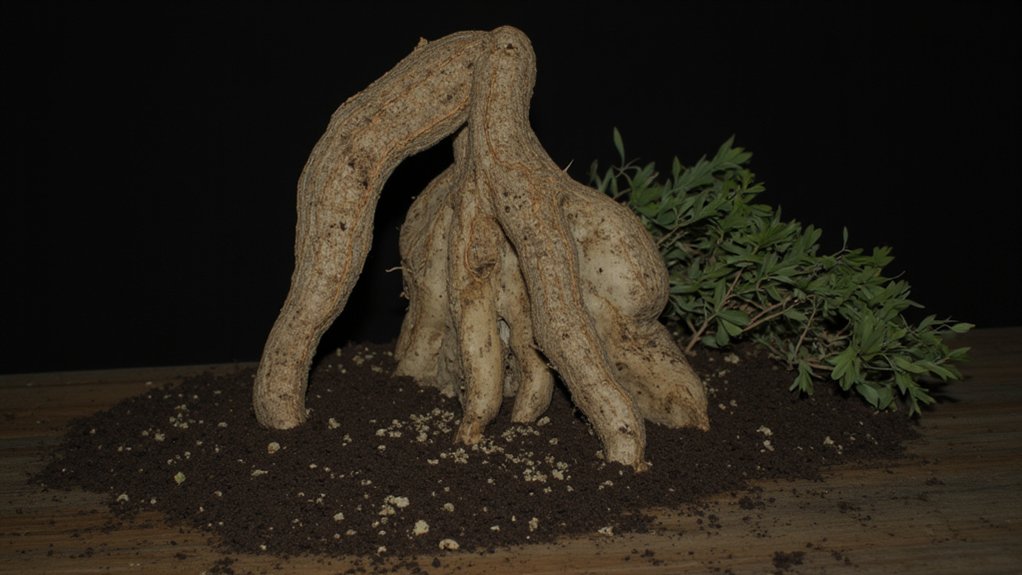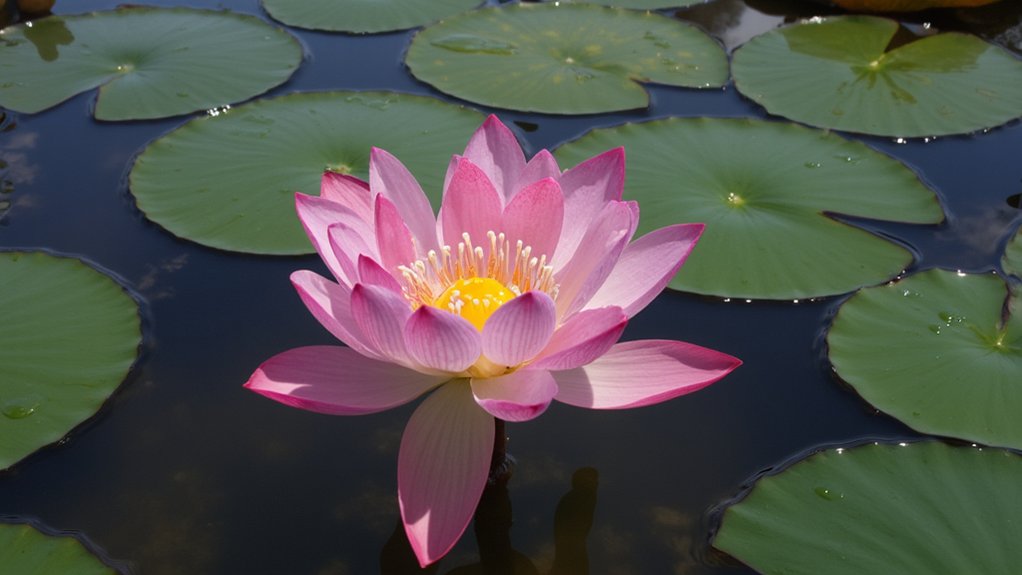You’ll discover that many common plants were once believed to possess extraordinary magical powers, from summoning spirits to warding off evil. Ancient civilizations developed elaborate rituals and mythologies around these botanical wonders, attributing supernatural qualities to their shapes, scents, and effects. While modern science has revealed the natural properties behind these plants’ behaviors, the fascinating legends surrounding them continue to capture our imagination and disclose deeper truths about human culture.
Contents
- 1 Mandrake Root: The Screaming Guardian of Ancient Lore
- 2 Sacred Lotus: Symbol of Creation in Egyptian Mythology
- 3 Witch Hazel: The Divining Rod of Natural Magic
- 4 Belladonna: The Deadly Nightshade of Medieval Europe
- 5 Dragon’s Blood Tree: Ancient Healing From Dragon Warriors
- 6 Frankincense: The Divine Scent of Sacred Ceremonies
- 7 St. John’s Wort: The Blessed Herb of Summer Solstice
- 8 Wolfsbane: Protector Against Mythical Creatures
- 9 Vervain: The Enchanted Herb of Celtic Druids
- 10 Sage: Sacred Smoke of Spiritual Cleansing
Mandrake Root: The Screaming Guardian of Ancient Lore

When you first encounter the legendary mandrake root, you’ll understand why ancient civilizations believed it possessed supernatural powers. Its thick, forked root often resembles human limbs, while the plant’s dark green leaves form a crown-like arrangement at ground level.
Medieval folklore claimed that mandrake roots would emit a fatal scream when pulled from the earth. Herbalists devised elaborate rituals, tying dogs to the plants and plugging their own ears with wax before extraction. You’ll find mandrake mentioned in ancient Greek texts, Hebrew scripture, and Shakespeare’s works.
The root contains powerful alkaloids that can cause hallucinations – perhaps explaining some of its mystical reputation.
Sacred Lotus: Symbol of Creation in Egyptian Mythology

As you gaze upon Egypt’s sacred lotus flower, you’ll witness one of ancient history’s most significant religious symbols. Rising from the murky depths of the Nile each morning, this remarkable plant opens its petals to the sun, mimicking the Egyptian creation myth of Ra emerging from primordial waters.
You’ll find the lotus depicted in countless temple carvings, where it represents rebirth, purity, and enlightenment. The ancient Egyptians believed its sweet fragrance was the very essence of the sun god, and priests would carefully cultivate these flowers in sacred pools, collecting their petals for religious ceremonies and medicinal purposes.
Witch Hazel: The Divining Rod of Natural Magic

Moving from Egypt’s sun-blessed lotus to the misty woods of North America, you’ll discover another plant steeped in mystical folklore. Witch hazel, with its spindly yellow flowers and unique Y-shaped branches, earned its reputation among early settlers and Native Americans as a supernatural tool.
You’ll find that these forked branches, traditionally cut at lengths of 12-24 inches, were used as divining rods to locate underground water sources. The practice, known as dowsing, involves holding the branch parallel to the ground until it supposedly dips downward, indicating hidden springs beneath the earth’s surface.
Despite modern skepticism, witch hazel’s practical medicinal properties continue to prove genuinely remarkable.
Belladonna: The Deadly Nightshade of Medieval Europe
Throughout medieval Europe’s dark history, belladonna earned its sinister reputation as both a deadly poison and a powerful hallucinogen. You’ll find that just two berries from this plant could kill a child, while 10-20 berries proved fatal for adults.
Medieval witches and healers often used belladonna in their flying ointments, believing it would help them soar through the night sky. They’d carefully mix the plant’s juice with animal fat and herbs, then apply it to their skin – though we now know these hallucinations came from the toxins entering their bloodstream.
The plant’s name, “beautiful lady,” stems from Renaissance women using diluted drops to dilate their pupils.
Dragon’s Blood Tree: Ancient Healing From Dragon Warriors
The crimson resin of the dragon’s blood tree captivated ancient civilizations, who believed it came from battling dragons whose blood stained the earth. This distinctive tree, native to Yemen’s Socotra Island, produces a deep red sap that’s been used medicinally for over 2,000 years.
You’ll find ancient Romans and Greeks used dragon’s blood as a treatment for respiratory issues, digestive problems, and wound healing. The resin contains powerful antimicrobial compounds that actually work to fight infection, validating its historical use.
Today, you can still purchase dragon’s blood extracts in natural health stores, where it’s sold as a remedy for skin conditions and internal ailments.
Frankincense: The Divine Scent of Sacred Ceremonies
Since ancient times, frankincense has held a revered place in religious ceremonies across multiple civilizations. You’ll find this aromatic resin mentioned in texts dating back to 1500 BCE, when it was worth its weight in gold.
To harvest frankincense, collectors make precise incisions in the Boswellia tree’s bark. The tree “bleeds” a milky white sap that hardens into yellowish-brown tears, which you can still find in markets today.
Ancient Egyptians burned frankincense daily in their temples, believing its smoke carried prayers to the gods. They also used it in the mummification process, where it served as both a practical preservative and spiritual connector.
St. John’s Wort: The Blessed Herb of Summer Solstice
Moving from temple incense to garden medicine, we find St. John’s Wort, a yellow-flowered herb that blooms around June 24th, the traditional feast day of St. John the Baptist. Ancient Europeans believed this timing wasn’t coincidental.
You’ll recognize the plant by its distinctive leaf feature – hold one up to sunlight, and you’ll see tiny perforations that look like holes. These “windows to heaven,” as medieval herbalists called them, inspired the plant’s Latin name, Hypericum perforatum.
In folklore, you’d gather St. John’s Wort at midnight on Midsummer’s Eve to ward off evil spirits and guarantee protection throughout the year.
Wolfsbane: Protector Against Mythical Creatures
While garden folklore often exaggerates claims about magical plants, wolfsbane’s historical reputation as a supernatural deterrent remains fascinating. You’ll find this striking purple flower, also known as monkshood or aconitum, growing in temperate regions worldwide.
Medieval Europeans believed that placing wolfsbane around their homes would protect them from werewolves, vampires, and shape-shifters. They’d strategically plant it near windows and doorways, creating what they considered a supernatural barrier.
Be cautious, though – all parts of wolfsbane contain deadly alkaloids. Even skin contact can cause severe reactions, which is why ancient herbalists used special gloves when handling it.
Vervain: The Enchanted Herb of Celtic Druids
Another legendary plant in ancient European folklore, vervain earned its reputation through its sacred status among Celtic druids. You’ll find that these ancient priests gathered this perennial herb at specific times, particularly during the summer solstice and without using iron tools.
The druids believed vervain possessed powerful protective properties, often hanging dried bundles above doorways to ward off evil spirits. They’d also sprinkle vervain-infused water around their homes and sacred spaces, creating what they called “magical boundaries.”
In traditional medicine, you’ll discover that vervain served as a remedy for headaches, insomnia, and anxiety. The herb’s bitter-tasting leaves were typically brewed into a tea.
Sage: Sacred Smoke of Spiritual Cleansing
Sacred sage has played a central role in spiritual cleansing rituals across numerous cultures for thousands of years. You’ll find this aromatic herb burning in Native American smudging ceremonies, ancient Roman purification rites, and modern meditation practices.
When you’re burning sage, you’ll want to use a heat-resistant container and bundle the dried leaves tightly. Ancient practitioners believed the smoke could dispel negative energy, evil spirits, and illness from spaces and people. They’d wave the burning bundle counterclockwise while chanting prayers.
The plant’s Latin name, Salvia, comes from “salvare,” meaning “to heal” or “to save,” reflecting its reputation for both medicinal and magical properties.
